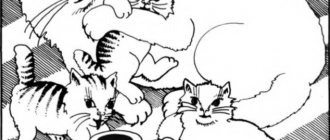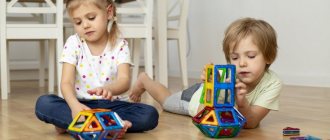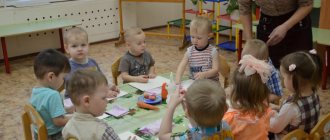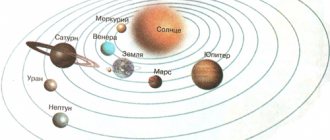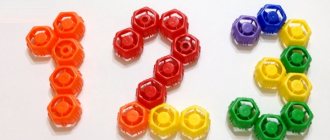Who's the odd one out?
It was necessary to find an extra card in a row.
A file with cards is possible.
Dasha could not find all the extra cards on her own; she needed a hint. For example, for these cards:
there was this hint: “Rockets are about to fly into space. Everyone was flying high, high! Up to the stars! But one did everything wrong! What kind of rocket was it?
In principle, such hints can be given to any row of cards if the child finds it difficult to choose the extra one. It’s just that it can be difficult for children to complete not the task itself, but to understand the logic of the question - how is it “extra”. Simple hints can help with this, and over time the child will get used to the concept of “extra” and learn to look for an extra card without hints.
For the fact that the child guessed every extra card, he is entitled to a PRIZE - the guessed card is given to him as a prize forever (children love small bright pictures, and usually the prospect of winning such a prize is very motivating to complete the task).
Presentation “About Space”
To begin with, we watched a presentation about space. You can download it from this link .
The presentation conveys the simplest and most basic concepts about space, which, in my opinion, a three-year-old can normally perceive. The text of the presentation is a little bookish (because I’m somehow ashamed guy
If you are interested in the presentation, I strongly encourage you to tell your child your own story about space when viewing it, based on the text and the meaning of the presentation pictures - in this case, the child will like it even more - because it will be “adjusted” personally for him .
Having examined Yuri Gagarin, Dasha Fr. It seems to me that this is a very accurate remark; it has always struck me that in almost all Soviet photographs this man pleases us with the most radiant smile.
Charging an astronaut
Flexible breaks between tasks are very important! Some children will not be able to conduct a lesson at all without them (we are just part of this group of “some” fidgets).
I told Dasha that we really need to fly into space, but only very strong people are accepted there and the astronauts train a lot before the flight. Therefore, we need to do good exercises.
The charging tasks were as follows (the pictures are not the most “designer” - I apologize, this is not my profile):
Exercise 1. Running around the room - for warming up.
Exercise 2. Walking on your toes, on your heels, walking along a massage path (any other massage surface - cereals, pebbles, pencils, etc.).
Fitball exercises.
(If you slightly change the exercises, you can use a simple ball of medium diameter. Attention! When performing all the exercises, hold the child tightly. You can secure the baby well if you take his two legs in your hands and press them tightly to the ball, and hold the ball itself with your feet. )
Exercise 3. We train the vestibular apparatus (everything like real astronauts). We sit the child on the ball, holding his legs tightly, and begin to bounce up and down on the ball (it turns out that the baby seems to be jumping on the ball). Then we place the child on his back on the ball and rotate the ball clockwise and counterclockwise.
We strengthen the abs and lower back muscles.
Exercise 4 . The child sits on the ball, the mother secures it well, taking both legs and pressing them to the ball (so as not to drop it! This is very important!). We begin to rock the child back and forth. We try to make the maximum possible amplitude.
Exercise 5. Swing the child on the ball left and right:
Exercise 6. Still fixing the child well, we rotate him and the ball in a plane parallel to the floor, clockwise and counterclockwise (as the green arrow in the photo suggests):
When performing these three exercises, the child will involuntarily deviate back and forth, while the abdominal and back muscles are well worked out.
Strengthening your arms and back.
Exercise 7. We ask the child to pick up toys from the floor (the toys are positioned so that he has to reach them in his arms):
Exercise 8. We ask the child to raise his hands up - we fly up like a rocket. If the child does not comply with the request, you can ask him to take the toy that we hold above his head.
Exercise 9. Walking on your hands around the room is an excellent exercise for your arms, back, and abs:
Exercise 10. Stepping over obstacles (strengthening the legs) - lay out tall objects on the floor (stuffed toys, pillows, stacks of books, anything taller than 30 cm). We ask the child to step over them (while raising his legs high).
Outdoor game.
This is a game for relaxing between classes and relieving mental stress. Additionally, using a simple example, we explain the movement of planets around the Sun.
We explain to the child in a simple way that the planets revolve around the sun. And we invite you to play it. The mother becomes the Sun, and the child becomes the planet. The mother takes the child by the hand and begins to spin him around (the child runs in a circle).
You can also play with the rotation of the Earth around its axis - tell your child about this and invite him to play with the idea that “we are planets and we rotate around our axis” - spin around himself.
Dasha, like any child, really enjoyed spinning around herself and spinning around her mother. At the same time, we took a little break.
A musical moment.
This minute was introduced to relax between tasks. I suggested that Dasha listen to “cosmic music”. We lay down on the pillows and turned on the music (this one). While listening to music, you can fantasize about what it wants to tell us about (the child will listen with interest as the music talks about how the ship is flying between the stars and planets, how there is darkness and cold for hundreds of kilometers around, and how it flies - swift , fast, beautiful to a distant planet, etc.). Playing “what the music says” is a very good way to develop an ear for music and the ability to truly appreciate and listen to music.
We launch a rocket into space.
I included this game as a “recess” so that the child could rest and play before the next task.
We took our constructed lego rocket and played launch. “Five-four-three-two-one-GO!” Our rocket flew through the airless space of the room and every now and then landed on different “planets”. At the end, the rocket returned home, the astronauts were greeted with applause and shouts of “Pos-drav-la-yu!” (everything is like in life). Dasha liked the moment of meeting the cosmonauts the most - she had to meet them three times.
Astronomy quiz for preschool children 6 - 7 years old with answers
Quiz about space for preschoolers 6 - 7 years old “Journey to the Solar Kingdom”
Author: Kovalchuk Valentina Nikolaevna. Educator. Kindergarten No. 90. city of Tyumen. Description: This quiz allows you to consolidate and expand children's knowledge of astronomy among preschoolers of the preparatory group and elementary school. It is very important that children receive the scientific foundations of astronomy in a language they can understand. Goal: To develop cognitive interest in astronomy. Objectives: To consolidate and clarify children’s ideas about planet Earth, the planets of the solar system, stars, some cosmic phenomena and objects moving throughout the Universe. Enrich and activate children's vocabulary in astronomy. Develop coherent dialogical speech in children. Develop visual-figurative thinking. Develop a culture of communication, the ability to listen without interrupting. Preparation: Reading books, looking at illustrations, making observations, memorizing poems, solving riddles.
Quiz progress
Questions and Answers
1. What is the sun? The sun is a star in the solar system. The Earth and other planets of the solar system revolve around the Sun. Child:
“Sunny is a coin,” the stingy one grumbled. No, a frying pan! - the glutton cried. “No, it’s a loaf,” the baker said. Compass,” the sailor said with conviction. The sun is a star, the astronomer announced. “A kind heart,” the dreamer decided.
2. Is it possible to walk on the Sun? No. The sun is a star, a huge hot ball of gas. If anything falls into the sun, it will immediately turn into gas. This is such unimaginable heat in the sun! 3. Why do people affectionately call the sun “sun”? Because people love the Sun. It shines, it warms, there is a whirlpool of water in nature, plants produce oxygen, solar power plants produce electricity. Child:
Our sun has a hundred worries: Heat our garden, Bloom all the flowers, Stay on the veranda, After a rain, on the run, Make a rainbow-arc.
And throw hemp on Natasha the Laughing One’s nose. 4. Where does the sun spend the night? Our planet Earth constantly rotates around its axis and exposes the sun's rays first to one side (then day comes), then the other side (then night comes). Child:
Why, in the evening, is the sun in a hurry to run away? Perhaps the sun has a desire to lie down? Probably the sun has a soft bed? It's probably too soft for the sun to sleep there! Maybe it’s just the sun that’s getting tired of shining for us And the sun really needs to recharge itself? Good night, sunshine! We can wait, and tomorrow with the first ray of light you will come to us again!
5. Why is there winter and summer? The imaginary axis of the planet Earth is tilted. Planet Earth moves in orbit around the Sun for a whole year. When the northern hemisphere, in which our country is located, turns away from the sun, winter sets in. It's summer in the southern hemisphere at this time. The Earth runs further in its orbit, and little by little the northern hemisphere turns towards the Sun and spring comes here, and then summer. In the southern hemisphere, autumn comes first, and then winter.
6. On what planet does day last for a whole year, and night lasts for a whole year? On Mercury. Why? Mercury rushes around the Sun in its orbit much faster than a spaceship, and rotates around itself very slowly: a year is day, a year is night.
7. How many planets are there in the solar system? Eight. In what order are they from the sun? Child:
In order, all the planets can be named by any of us: One - Mercury, Two - Venus, Three - Earth, Four - Mars. Five is Jupiter, Six is Saturn, Seven is Uranus, followed by Neptune. Author: Arkady Khait
8. Why is Mars red? The earth on Mars is red-brown in color. 9. Which planet is the largest? Jupiter.
10. What is the name of a star that is visible even during the day? This is the planet Venus. It appears to be a shiny silver ball, but it does not glow itself, but simply reflects sunlight. Up close, its surface is reddish-brown.
11. Why does everything fall to Earth? The force of gravity acts.
12. Why doesn't the Moon fall to Earth? The Moon is a satellite of the Earth (it rotates around the Earth in its orbit). Like the Earth and other planets of the solar system are satellites of the Sun (rotate around it).
13. Why is the Moon in the evening sky sometimes full and round, sometimes only half visible, sometimes a thin crescent? The moon circles our planet in 28 days. And the part of the Moon that is illuminated by the Sun is bright.
14. Which planets do not have satellites? At Mercury and Venus. Which planet has the most satellites? Jupiter now has 60 known.
15. Each planet has something of its own, which most clearly distinguishes it. You will certainly recognize Saturn by sight - It is surrounded by a large ring. It is not continuous, it is made up of different stripes. Saturn has the most developed ring system. What are Saturn's rings made of? Saturn's rings made of dust and ice.
16. What are stars? Child:
What are stars? If they ask you, answer boldly: Hot gas. And add that, moreover, there is always a Nuclear Reactor - Every star! Author: Rimma Aldonina
17. Is it possible to count the stars in the sky? No. 18. Can stars fall from the sky? No. These small solid meteoric bodies, falling from outer space, become heated and, burning, begin to glow like stars. 19. What have astronomers done to better navigate the sky? Astronomers divided the sky into regions, and the stars into groups, constellations. They connected the brightest stars in the group with each other with imaginary lines and looked at what they resembled. This is how Cancer, Swan, Cassiopeia, Hercules, Ursa Major and Ursa Minor appeared in the sky...
20. What are the names of the astronomical buildings in which scientists observe and study the stars? Observatories. They are located far from populated areas or in the mountains. Equipped with telescopes. After all, you can only watch the stars in a clear sky.
21. What are the names of the instruments through which you can observe the stars? Telescopes. 22. Milky Way. What is this? Child:
The black velvet of the sky is embroidered with stars. A bright path runs across the sky. It spreads easily from edge to edge, as if someone spilled milk across the sky. But, of course, there is no milk or juice in the sky, We see our star system from the side. This is how we see the Galaxy. Our distant native light is space for astronautics for many thousands of years. Author: Rimma Aldonina.
Outdoor game “Let's collect the stars”
The teacher lays out multi-colored stars in the group. You need to collect the stars in different baskets, sorting by color.
Puzzles
The third from the sun, not the largest of the planets.
But of all the planets, it is the only one on which there is life. (Earth)
A large bucket is visible in the sky. Children dream of drinking from it. (Big Dipper)
At night he looks into the darkness through a huge pipe. He wants to discover his very distant star. (Astronomer)
There is a special tube, In it the Universe is visible, Astronomers see the kaleidoscope of stars in ... (telescope).
They shine in the sky in the dark, Although no one turns them on. (Stars)
You come to us from space, pulling your long tail behind you. Some of you visit us more than once. (Comet)
You are the empty areas of the Universe Beyond the boundaries of celestial bodies. You are darkness, almost a vacuum, Disturbing the minds of scientists. (Space)
Twelve times a year he is born, sometimes he loses weight, sometimes he gets better. It illuminates a clear night, but does not warm. (Moon, month)
Solid body from outer space Weighing from grams to tons. It flies through the atmosphere and lands on Earth. (Meteorite)
A wide white stripe across the sky stretched across the night sky, dividing it in half. (Milky Way)
Child:
The black velvet of the sky is embroidered with stars.
A bright path runs across the sky. It spreads easily from edge to edge, as if someone spilled milk across the sky. But, of course, there is no milk or juice in the sky, We see our star system from the side. This is how we see the Galaxy. Our distant native light is space for astronautics for many thousands of years. Author: Rimma Aldonina Above the forest, above the mountains, a carpet spreads. It is spread out like a tent over you and over me, Sometimes it is gray, sometimes it is blue, sometimes it is bright blue. (Sky)
He flies around the Earth and does scientific work. It flies in a given orbit. It's shining like a star in the sky. It is the sun that illuminates it. It reflects the light. (Artificial Earth satellite)
Outdoor game “Cosmonauts” Hoops are laid out in a circle. Children run freely around the hoops and say the words: Fast rockets are waiting for us to fly around the planets. Whichever one we want, we’ll fly to that one! But there is one secret in the game - there is no room for latecomers! After the last words, the children take their places in their rockets. Then everyone stands in a circle again and the game starts all over again. Each time the teacher removes several hoops. The game is repeated until only one hoop remains. Quiz results
Presentation on the topic: Astronomy riddles
We recommend watching:
Quiz with answers on fairy tales for children of the preparatory group Interesting questions on fairy tales for children of the preparatory group Quiz with answers on the topic: Summer for children of the preparatory group Quiz with answers for children 5-7 years old. Inhabitants of Africa
Similar articles:
Quiz on the topic “Trees and shrubs” for children 5-7 years old
Quiz on the topic “Wild Animals” for children 5-7 years old
Quiz on the theme “Birds” for children 6-7 years old
Quiz with answers “Andersen's Fairy Tales” for preschoolers
Quiz with answers “Fairy Tales of Charles Perrault” for preschoolers

